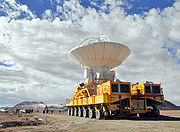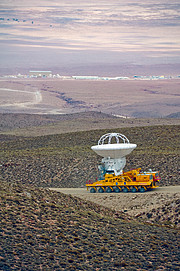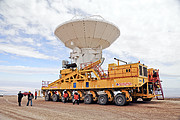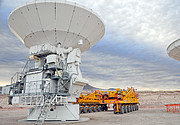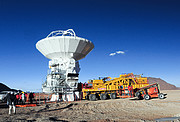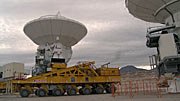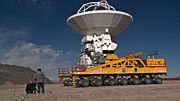Comunicato Stampa
ALMA raggiunge nuove vette
23 Settembre 2009
L’osservatorio astronomico ALMA (Atacama Large Millimeter/submillimeter Array) ha fatto un altro passo avanti- o meglio...in alto. Infatti una delle sue antenne più avanzate è stata portata da un trasportatore gigante costruito appositamente sull’altipiano di Chajnantor, alla quota di 5000 metri, nelle Ande Cilene. L’antenna, che pesa circa 100 tonnellate e ha un diametro di 12 metri, è stata trasportata al sito più in alto, l’Array Operations Site, dove l’aria estremamente secca e rarefatta è ideale per le osservazioni dell’Universo.
Le condizioni presso l’ Array Operations Site (Sito di Operazioni della Serie di Antenne) sul Chajnantor sono eccellenti per l’astronomia, ma anche molto dure. Lavorare lassù, con la metà dell’ossigeno disponibile rispetto al livello del mare, è molto difficile. Per questa ragione le antenne di ALMA sono assemblate e sottoposte a test a 2900 metri di altezza, presso la struttura di supporto (Operations Support Facility, OSF). È proprio da questo relativamente ospitale campo base che l’antenna di ALMA ha iniziato il suo viaggio verso la parte più alta del Chajnantor.
"Questo è un momento importante per ALMA. Siamo molto felici che il primo trasporto di un’antenna al sito in quota sia proceduto senza problemi. Questo risultato è stato possibile solo grazie al contributo di tutti i partner internazionali di ALMA: questa antenna in particolare è fornita dal Giappone, il trasportatore dall’Europa e l’elettronica all’interno dell’antenna da Nord America, Europa e Asia”, ha commentato Wolfgang Wild, l’ALMA Project Manager europeo.
Il viaggio è iniziato quando Otto, uno dei due trasportatori meccanici di ALMA, ha sollevato l’antenna su di sé. Otto ha trasportato il suo pesante carico lungo i 28 km di strada che separano l’Operations Support Facility dall’ Array Operations Site. Il trasportatore può raggiungere velocità medie di 12 km/ora anche quando carica un’antenna, ma in questo primo percorso è avanzato più lentamente, per verificare che tutto funzionasse come previsto. Il tragitto è durato 7 ore.
Le antenne di ALMA sono le antenne in regime submillimetrico più avanzate mai costruite.
Sono progettate per operare completamente esposte alle dure condizioni atmosferiche presso l’Array Operations Site. Ciò significa che devono resistere a forti venti e temperature tra +20 e -20 gradi Celsius, mentre devono puntare con precisione tale che potrebbero cogliere una pallina da golf a distanza di 15 km. Inoltre le loro superfici riflettenti devono rimanere lisce, con un’accuratezza migliore di 25 micrometri (meno dello spessore di un tipico capello umano).
“Trasportare la nostra prima antenna sull’altopiano di Chajnantor è stata un’impresa epica, che esemplifica i tempi emozionanti che ALMA sta vivendo. Giorno dopo giorno, la nostra collaborazione globale ci porta più vicini alla nascita del più ambizioso osservatorio astronomico da Terra esistente al mondo,” ha detto Thijs de Graauw, direttore di ALMA.
Una volta raggiunto l’alto plateau, il trasportatore ha condotto l’antenna su una piattaforma di cemento – una stazione di ormeggio con tutte le connessioni per l’energia e le fibre ottiche- e l’ha posizionata con una accuratezza di pochi millimetri. Il trasportatore è guidato da un sistema laser per le manovre e, come alcune automobili attuali, è dotato di rivelatori a ultrasuoni per evitare collisioni. Questi sensori assicurano l’incolumità di queste antenne modernissime mentre il trasportatore le conduce attraverso quello che tra poco diventerà un altipiano molto affollato. Infatti alla fine ALMA avrà almeno 66 antenne, distribuite su oltre 200 piattaforme, distanti fra loro al massimo 18.5 km, e che agiranno come un singolo telescopio gigante.
Anche quando ALMA sarà completamente in funzione, i trasportatori saranno utilizzati per spostare le antenne da una piattaforma all’altra per riconfigurare il telescopio adattandolo a differenti tipi di osservazioni.
La prima antenna di ALMA sul sito ad altitudine maggiore verrà presto raggiunta da altre antenne, e il gruppo di ALMA non vede l’ora di fare le prime osservazioni dall’altopiano di Chajnantor. Prevedono di unire tre antenne agli inizi del 2010, e di svolgere le prime osservazioni scientifiche con ALMA nella seconda metà del 2011.
ALMA aiuterà gli astronomi a rispondere a domande fondamentali sulle nostre origini cosmiche. Il telescopio osserverà l’Universo nelle lunghezze d’onda millimetriche e submillimetriche, ovvero nello spettro elettromagnetico tra la luce infrarossa e le onde radio.
La luce a queste lunghezze d’onda proviene da alcuni tra i più freddi e distanti oggetti del cosmo. Questi includono nuvole di gas e polveri dove stanno nascendo nuove stelle e remote galassie ai confini dell’universo visibile. L’Universo è relativamente inesplorato a lunghezze d’onda submillimetriche, poiché un telescopio così necessita di condizioni atmosferiche estremamente aride, come quelle presenti sul Chajnantor, e di rivelatori a tecnologia avanzata.
Ulteriori Informazioni
Il progetto ALMA è una collaborazione fra l’Europa, il Giappone e il Nord America, in cooperazione con la Repubblica Cilena. La costruzione e la gestione di ALMA per conto dell’Europa sono condotte dall'ESO. ALMA, il più grande progetto astronomico esistente, è un telescopio rivoluzionario, una serie di 66 di antenne submillimetriche e millimetriche dal diametro di 12 e 7 metri. ALMA iniziera’ le osservazioni scientifiche nel 2011.
L’ESO (European Southern Observatory) è la principale organizzazione intergovernativa di Astronomia in Europa e l’osservatorio astronomico più produttivo al mondo. È sostenuto da 14 paesi: Austria, Belgio, Repubblica Ceca, Danimarca, Finlandia, Francia, Germania, Italia, Olanda, Portogallo, Spagna, Svezia, Svizzera e Gran Bretagna. L’ESO mette in atto un ambizioso programma che si concentra sulla progettazione, costruzione e gestione di potenti strutture astronomiche da terra che consentano agli astronomi di fare importanti scoperte scientifiche. L’ESO ha anche un ruolo preminente nel promuovere e organizzare cooperazione nella ricerca astronomica. L’ ESO gestisce tre siti unici di livello mondiale in Cile: La Silla, Paranal e Chajnantor. A Paranal, l’ESO gestisce il Very Large Telescope, l’osservatorio astronomico nella banda visibile più d’avanguardia al mondo. L’ESO è il partner europeo di un telescopio astronomico rivoluzionario, ALMA, il più grande progetto astronomico esistente. L’ESO sta pianificando al momento un Telescopio Europeo Estremamente Grande ottico/vicino-infrarosso di 42 metri, l’E-ELT, che diventerà “il più grande occhio del mondo rivolto al cielo”.Links
Maggiori informazioni su ALMA sul sito:
http://www.almaobservatory.org/
Contatti
Wolfgang Wild
ESO
Garching, Germany
Tel.: +49 89 3200 6716
E-mail: wwild@eso.org
Douglas Pierce-Price
ESO
Garching, Germany
Tel.: +49 89 3200 6759
E-mail: dpiercep@eso.org
Anna Wolter (press contact Italia)
Rete di divulgazione scientifica dell'ESO
e INAF-Osservatorio Astronomico di Brera
Milano, Italy
Tel.: +39 02 72320321
E-mail: eson-italy@eso.org
Sul Comunicato Stampa
| Comunicato Stampa N": | eso0935it |
| Legacy ID: | PR 35/09 |
| Nome: | Atacama Large Millimeter/submillimeter Array |
| Tipo: | Unspecified : Technology : Observatory : Telescope |
| Facility: | Atacama Large Millimeter/submillimeter Array |
Our use of Cookies
We use cookies that are essential for accessing our websites and using our services. We also use cookies to analyse, measure and improve our websites’ performance, to enable content sharing via social media and to display media content hosted on third-party platforms.
ESO Cookies Policy
The European Organisation for Astronomical Research in the Southern Hemisphere (ESO) is the pre-eminent intergovernmental science and technology organisation in astronomy. It carries out an ambitious programme focused on the design, construction and operation of powerful ground-based observing facilities for astronomy.
This Cookies Policy is intended to provide clarity by outlining the cookies used on the ESO public websites, their functions, the options you have for controlling them, and the ways you can contact us for additional details.
What are cookies?
Cookies are small pieces of data stored on your device by websites you visit. They serve various purposes, such as remembering login credentials and preferences and enhance your browsing experience.
Categories of cookies we use
Essential cookies (always active): These cookies are strictly necessary for the proper functioning of our website. Without these cookies, the website cannot operate correctly, and certain services, such as logging in or accessing secure areas, may not be available; because they are essential for the website’s operation, they cannot be disabled.
Functional Cookies: These cookies enhance your browsing experience by enabling additional features and personalization, such as remembering your preferences and settings. While not strictly necessary for the website to function, they improve usability and convenience; these cookies are only placed if you provide your consent.
Analytics cookies: These cookies collect information about how visitors interact with our website, such as which pages are visited most often and how users navigate the site. This data helps us improve website performance, optimize content, and enhance the user experience; these cookies are only placed if you provide your consent. We use the following analytics cookies.
Matomo Cookies:
This website uses Matomo (formerly Piwik), an open source software which enables the statistical analysis of website visits. Matomo uses cookies (text files) which are saved on your computer and which allow us to analyze how you use our website. The website user information generated by the cookies will only be saved on the servers of our IT Department. We use this information to analyze www.eso.org visits and to prepare reports on website activities. These data will not be disclosed to third parties.
On behalf of ESO, Matomo will use this information for the purpose of evaluating your use of the website, compiling reports on website activity and providing other services relating to website activity and internet usage.
Matomo cookies settings:
Additional Third-party cookies on ESO websites: some of our pages display content from external providers, e.g. YouTube.
Such third-party services are outside of ESO control and may, at any time, change their terms of service, use of cookies, etc.
YouTube: Some videos on the ESO website are embedded from ESO’s official YouTube channel. We have enabled YouTube’s privacy-enhanced mode, meaning that no cookies are set unless the user actively clicks on the video to play it. Additionally, in this mode, YouTube does not store any personally identifiable cookie data for embedded video playbacks. For more details, please refer to YouTube’s embedding videos information page.
Cookies can also be classified based on the following elements.
Regarding the domain, there are:
- First-party cookies, set by the website you are currently visiting. They are stored by the same domain that you are browsing and are used to enhance your experience on that site;
- Third-party cookies, set by a domain other than the one you are currently visiting.
As for their duration, cookies can be:
- Browser-session cookies, which are deleted when the user closes the browser;
- Stored cookies, which stay on the user's device for a predetermined period of time.
How to manage cookies
Cookie settings: You can modify your cookie choices for the ESO webpages at any time by clicking on the link Cookie settings at the bottom of any page.
In your browser: If you wish to delete cookies or instruct your browser to delete or block cookies by default, please visit the help pages of your browser:
Please be aware that if you delete or decline cookies, certain functionalities of our website may be not be available and your browsing experience may be affected.
You can set most browsers to prevent any cookies being placed on your device, but you may then have to manually adjust some preferences every time you visit a site/page. And some services and functionalities may not work properly at all (e.g. profile logging-in, shop check out).
Updates to the ESO Cookies Policy
The ESO Cookies Policy may be subject to future updates, which will be made available on this page.
Additional information
For any queries related to cookies, please contact: pdprATesoDOTorg.
As ESO public webpages are managed by our Department of Communication, your questions will be dealt with the support of the said Department.

